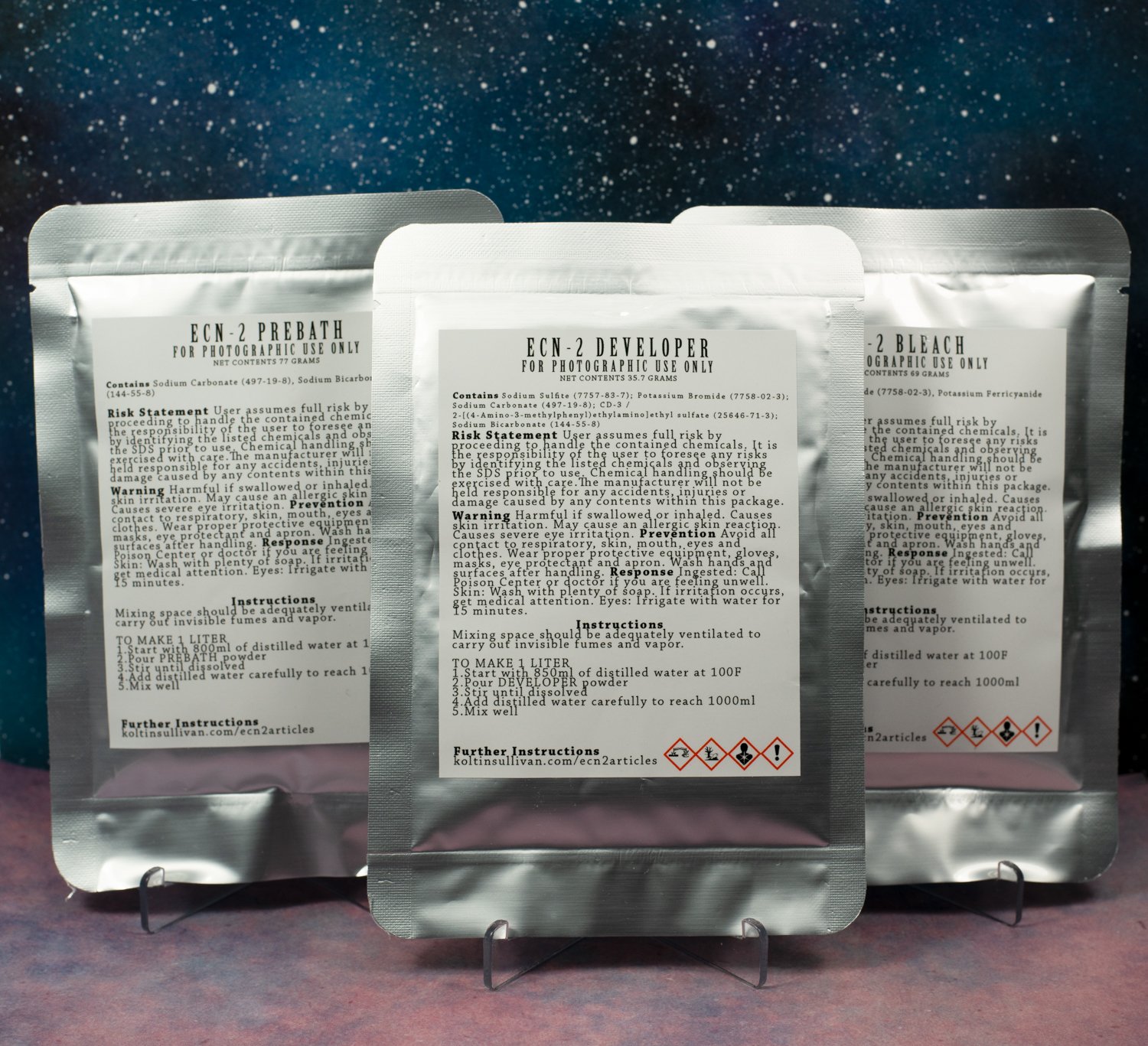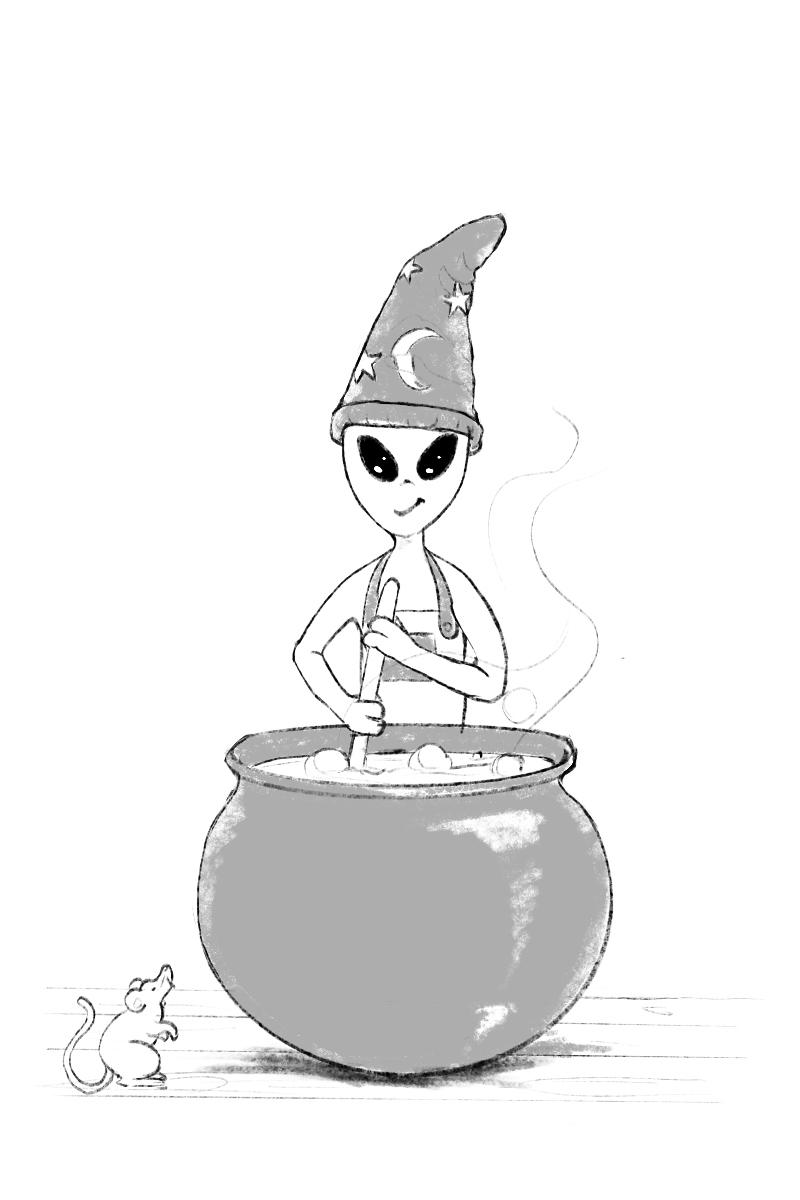

ECN-2 CHEMISTRY KIT 1 LITER
The Art of Processing Film
Processing your own film is not only a rewarding feeling, it allows complete creative control by playing with agitation and time to which you can distinguish your own look. By investing a bit of time learning the process, you can save on gas or postage costs to labs and have your negatives ready in an hour. I’ve had negatives stolen in the mail or lost in the mail , so this will guarantee security in your negatives as well. Saving money of course is a giant incentive, for the equivalent cost of the kit is as much as getting 1 roll of film developed at a lab. Since processing myself I have gained a lot more confidence while shooting, I can previsualize better and my light metering has improved understanding The Zone System.
With this 1L kit, you can process at least 12 rolls of 35mm/120 (they roughly have about the same surface area).
I try to use mine within a month. It all depends on how you store it, and what you deem as acceptable results, both of which will determine the longevity. This only comes through keeping tabs on how many rolls you process with it and the duration of time. I filter my chemicals with coffee filters, it catches loose rem-jet and dust that’s been accumulating in the tank, in the air, etc. In my experience it has been a safe practice and the quality of the negatives improves by having less contaminants. Some solution may precipitate if the temperature is below 60F. Storage life of solutions can decrease if stored in temperatures above 75F.
Use a fixer with a pH between 5.5 and 6.5 , I recommend Foma Fomafix which has a pH between 5.5 and 5.8 .
At the top-secret labs they use replenisher, which is a stronger solution in order to keep the same processing times. Since aeration oxidizes the chemistry and wash water dilutes it , it’s best to extend the chemistry times to compensate for the lost chemical power.
I mix 1L of final rinse then reuse as long as there aren’t huge contaminates floating in the solution. If you’re not a gambler, then remixing with distilled water will guarantee you best results.
I mix 1L of stop bath and reuse twice. Unless you have a pH meter to continuously track it, it’s better to play on the safe side. I wouldn’t use a citric acid stop either, since it’s organic and bacteria can growth and thrive in it, (this means ILFOSTOP gets abducted). Don’t use black-and-white stop bath , or water either. The developing time is shorter than black-and-white, and needs to be stopped at all 3 layers, so it needs a lower pH chemical to do that. I recommend an Acetic Acid based stop, LegacyPro Indicator Stop Bath.
Seconds to Add After Each Roll
Prebath: 1
Developer: 6
Stop Bath: 1
Bleach: 2
Fixer: 4
Final Rinse: 1
Example: You’ve already developed 6 rolls, and you have 3 in the tank right now ready to process. Now you would do Prebath for 16 seconds, Developer for 3 minutes 36 seconds, Stop Bath 30 seconds, Bleach for 3 minutes 12 seconds, Fixer for 2 minutes 24 seconds, Final Rinse for 16 seconds.
Keep track of how many rolls go through each chemical. This will help you later on to learn capacity for your system. I would clean all bottles when remixing, use the same bottles for the same solution and replace Developer and Fixer first, this can eliminate most flake, white dots, silver participating and being embedded into the emulsion issues. Tiny invisible silver precipitates from fixer can imbed themselves into the emulsion and is impossible to get out, even rewashing. When in doubt, “Fresh Chemistry is Always Better”, that’s what the aliens always say at least…
In my tests, Prebath gets the most dust since it touches the dry tank first. Developer and Bleach have rem-jet contaminates, and Fixer has silver precipitates.
Processing Outline
Prebath [80°F ± 2.0] 0:10
Remjet Removal Shake 0:10 [90°F]
Remjet Removal Shake 0:15 [100F] x3
Developer [106°F ± 0.2] 3:00
+1 Stop 3:40
+2 Stop 4:40
Stop Bath [80-100°F] 0:30
Ilford Wash Method [100°F] 2:00
Ferricyanide Bleach [100°F ± 2.0] 3:00
Ilford Wash Method [100°F] 2:00
Fixer [100°F ± 2.0] 2:00
Final Wash [100°F] 6:00
Final Rinse [80-100°F] 0:10
The Art of Processing Film
Processing your own film is not only a rewarding feeling, it allows complete creative control by playing with agitation and time to which you can distinguish your own look. By investing a bit of time learning the process, you can save on gas or postage costs to labs and have your negatives ready in an hour. I’ve had negatives stolen in the mail or lost in the mail , so this will guarantee security in your negatives as well. Saving money of course is a giant incentive, for the equivalent cost of the kit is as much as getting 1 roll of film developed at a lab. Since processing myself I have gained a lot more confidence while shooting, I can previsualize better and my light metering has improved understanding The Zone System.
With this 1L kit, you can process at least 12 rolls of 35mm/120 (they roughly have about the same surface area).
I try to use mine within a month. It all depends on how you store it, and what you deem as acceptable results, both of which will determine the longevity. This only comes through keeping tabs on how many rolls you process with it and the duration of time. I filter my chemicals with coffee filters, it catches loose rem-jet and dust that’s been accumulating in the tank, in the air, etc. In my experience it has been a safe practice and the quality of the negatives improves by having less contaminants. Some solution may precipitate if the temperature is below 60F. Storage life of solutions can decrease if stored in temperatures above 75F.
Use a fixer with a pH between 5.5 and 6.5 , I recommend Foma Fomafix which has a pH between 5.5 and 5.8 .
At the top-secret labs they use replenisher, which is a stronger solution in order to keep the same processing times. Since aeration oxidizes the chemistry and wash water dilutes it , it’s best to extend the chemistry times to compensate for the lost chemical power.
I mix 1L of final rinse then reuse as long as there aren’t huge contaminates floating in the solution. If you’re not a gambler, then remixing with distilled water will guarantee you best results.
I mix 1L of stop bath and reuse twice. Unless you have a pH meter to continuously track it, it’s better to play on the safe side. I wouldn’t use a citric acid stop either, since it’s organic and bacteria can growth and thrive in it, (this means ILFOSTOP gets abducted). Don’t use black-and-white stop bath , or water either. The developing time is shorter than black-and-white, and needs to be stopped at all 3 layers, so it needs a lower pH chemical to do that. I recommend an Acetic Acid based stop, LegacyPro Indicator Stop Bath.
Seconds to Add After Each Roll
Prebath: 1
Developer: 6
Stop Bath: 1
Bleach: 2
Fixer: 4
Final Rinse: 1
Example: You’ve already developed 6 rolls, and you have 3 in the tank right now ready to process. Now you would do Prebath for 16 seconds, Developer for 3 minutes 36 seconds, Stop Bath 30 seconds, Bleach for 3 minutes 12 seconds, Fixer for 2 minutes 24 seconds, Final Rinse for 16 seconds.
Keep track of how many rolls go through each chemical. This will help you later on to learn capacity for your system. I would clean all bottles when remixing, use the same bottles for the same solution and replace Developer and Fixer first, this can eliminate most flake, white dots, silver participating and being embedded into the emulsion issues. Tiny invisible silver precipitates from fixer can imbed themselves into the emulsion and is impossible to get out, even rewashing. When in doubt, “Fresh Chemistry is Always Better”, that’s what the aliens always say at least…
In my tests, Prebath gets the most dust since it touches the dry tank first. Developer and Bleach have rem-jet contaminates, and Fixer has silver precipitates.
Processing Outline
Prebath [80°F ± 2.0] 0:10
Remjet Removal Shake 0:10 [90°F]
Remjet Removal Shake 0:15 [100F] x3
Developer [106°F ± 0.2] 3:00
+1 Stop 3:40
+2 Stop 4:40
Stop Bath [80-100°F] 0:30
Ilford Wash Method [100°F] 2:00
Ferricyanide Bleach [100°F ± 2.0] 3:00
Ilford Wash Method [100°F] 2:00
Fixer [100°F ± 2.0] 2:00
Final Wash [100°F] 6:00
Final Rinse [80-100°F] 0:10